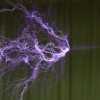BE YOUR OWN FISH FINDER
Part One: The patterns fish make in the water and what they tell us.

I am directing this towards shore fishermen, for when you are fishing offshore in a boat most likely you are using electronic devices. You can still use some of the technique I want to share with you though. These skills I acquired from many years of studying water and the habits of fish I was trying to catch. I also learned some of these tactics from fellow fishermen.
Let me give you an example of one of the “patterns” I watch for that help me locate fish. I live close to the Saint John River in Florida and will spend a lot of time studying the water there and using what I learn to catch fish. One evening I was intently watching a drama unfold right before my eyes. A school of small bait-fish was being attacked by fish approximately the size of my hand. (They were probably Mango Snapper). A woman walked by me and looks down at the water ware I was staring, and then looked at me totally mystified. I remained quit, for I was rather enjoying the fact that I was the only one aware of the struggle for survival happening about three feet away from me. Let her think I was crazy, for she was the one that was missing the show.
This is what I observed and why I knew what was really going on. There was a circular movement of water, sort of like a miniature whirlpool, and heading towards this “whirlpool” was two “v” shaped “wakes,” from opposite sides of the whirlpool, one in front and one heading towards the back. Bait-fish was causing this whirlpool as a defensive maneuver. When a school of bait-fish is being fed on by predatory fish, they will respond in several different ways.
- They will bunch together, a lot of times forming a “ball-like” formation. This is what a lot of seasoned fishermen call a “bait ball.”
- They will scatter, “every fish for them selves” mentality- with each fish heading in a different direction.
- The school will stick together, but start to swim in a zigzag motion.
- They will stick together and then swim in a tight circle, kind of like “circling the wagons.”
- They will leap out of water and “fly” as far as they can before hitting the water again.
The situations I described above, with the school circling, usually means that the baitfish are being surrounded by feeding fish and are being forced to circle. If you do not see “v shapes” moving towards the school, this means that the baitfish are being attacked by fish from bellow the school.
Now, how did I know the size of the fish that were feeding? Well, you could say the size of the “v wake” right? Not always for some fish will make a smaller wake than there size, because they are not right bellow the surfaces of the water but close enough to still create a wake.
The reason I knew the size of fish was that they were in shallow water but not shallow enough to cause a splash as they went in for the kill. If you wanted to try to catch these fish, you may have difficulty in doing so, at lease the ones that are feeding on the school of baitfish. What I would do is attempt to get some of the baitfish that are being feed on and then use a bobber placed about two feet above the bait. I would then cast out a couple feet past the school, for other predator fish might be coming in to join the party!
A more obvious sign would be to see a fish splash as it caches its prey on the surface. This is referred to as “a boil.” What a lot of fishermen do is cast right were they see the boil and then wonder why they do not get a strike. The reason is most likely the fish is spooked by the fact its prey just magically appeared right in front of it were it just feed. The fish knows that your offering was no were around a moment ago. Its instincts are flashing warning lights!
What I would do instead, is wait a minute, then place my offering in the same area the fish seems to be moving, let say, five or six feet in front of him. This of course depends on what kind of fish you trying to catch. However, if a school of predator fish is feeding on the surface, on a large school of bait-fish, they can reach such frenzy that you can just about cast anything shiny at them and they will usually hit it. Also, sea birds will follow hoping to pick off whatever bait-fish they can. This leads me to Part Two, Nature’s Dead Giveaways. Here I will talk about birds, and other ways to locate hot fishing spots, coming soon to a Hub page near you!








